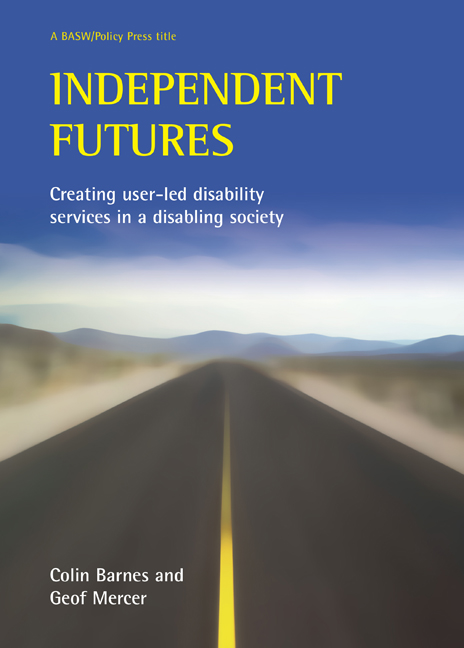Book contents
- Frontmatter
- Contents
- List of figures and tables
- Acknowledgements
- Notes on the authors
- one Examining user-led services
- two Traditional approaches: disability policy and the welfare state
- three Disability activism and the struggle for independent living
- four Researching user-led organisations
- five User-led organisations: building an alternative approach
- six Service design and delivery: opportunities and constraints
- seven Service users’ views and experiences
- eight Politics and campaigning
- nine Policy change or retrenchment?
- ten Future directions
- References
- Index
two - Traditional approaches: disability policy and the welfare state
Published online by Cambridge University Press: 15 January 2022
- Frontmatter
- Contents
- List of figures and tables
- Acknowledgements
- Notes on the authors
- one Examining user-led services
- two Traditional approaches: disability policy and the welfare state
- three Disability activism and the struggle for independent living
- four Researching user-led organisations
- five User-led organisations: building an alternative approach
- six Service design and delivery: opportunities and constraints
- seven Service users’ views and experiences
- eight Politics and campaigning
- nine Policy change or retrenchment?
- ten Future directions
- References
- Index
Summary
Introduction
This chapter provides an overview of social policies that have influenced the lives of people with impairments, and how these have changed historically across different political and economic contexts. First, we outline available assistance from the 17th to the early 20th century for individuals broadly categorised as ‘sick and infirm’. This ranged from state poor relief and charitable aid, to ‘informal’ support from family members and the local community. Into the 19th century, there was increasing resort to segregation in institutions. By the start of the 20th century, with poverty increasingly regarded as a social problem requiring collective action, Poor Law relief was being supplanted by an alternative state-regulated package of social security, old age and war pensions, and National Insurance benefits.
Second, the consolidation of the welfare state in the 1940s is reviewed. This promised a major change in the direction of social policy, with an emphasis on the principle of equal citizenship that included a range of measures directed at disabled people. In practice, state services failed to make the anticipated advances in the social and economic conditions of disabled people, and the reliance on the voluntary sector and ‘informal carers’ continued. Third, the dominance of a ‘personal tragedy’ and medicalised view of ‘disability’ in policy reforms and service provision is highlighted. This was legitimised by the ascendancy of a scientific medical profession. Its emphasis on individual cure and rehabilitation endured through the 20th century, although at its end policy makers began to acknowledge a contrary perspective, promoted by disability activists, which stressed the social barriers to inclusion.
In the final section, we outline the reforms since the 1970s to the welfare state and public sector provision. Initiatives from both Conservative and New Labour governments promoted a ‘mixed economy of welfare’ and consumerism, along with novel forms of governance, but these failed to deliver major progress in overturning the social exclusion of disabled people.
Historical perspectives on disability policy
Most notably during the 16th century, the state became a site of continuing public debate about how to resolve the competing demands of ‘at least two distributive systems, one based on work and one on need’ (Stone, 1985, p 15).
- Type
- Chapter
- Information
- Independent FuturesCreating User-Led Disability Services in a Disabling Society, pp. 9 - 28Publisher: Bristol University PressPrint publication year: 2006

